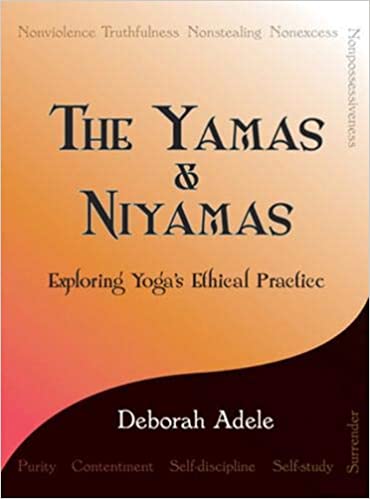
In a world filled with desires and constant competition, the concept of Asteya, or non-stealing, emerges as a fundamental principle not only in yoga but also in various aspects of life. This ancient practice, rooted in the ethical teachings of sage Patanjali, offers profound insights into personal growth, societal harmony, and spiritual development.
Mahatma Gandhi’s quote resonates deeply with this principle: “The world has enough for everyone’s need, but not enough for everyone’s greed.”
This illustrates the idea that abundance exists, but greed and desire can lead to scarcity. Asteya encourages us to recognize the sufficiency in our lives and promotes a mindset of generosity and gratitude..
What is Asteya?
In the series of 5 Yamas (social ethics) explained by sage Patanjali in Yoga Sutras, Asteya is the third Yama which literally means Non-stealing.
To understand Asteya (non-stealing), one needs to realize the truth that their way to happiness doesn’t lie in snatching away the possessions of another. Therefore, in the path of yoga (and also in daily life), asteya is restraining from taking what does not belong to you, what isn’t needed, and what is more than your share.
The word Asteya can have a few other implications besides non-stealing, like, non-covetousness and generosity. At the heart of this practice is to restrain from expressing possession of anything that contributes to the well-being of other creations.
However, the practice of Asteya expands beyond the physical activity of stealing. According to the texts compiled by Patanjali, Asteya should be practiced in action, words, and thoughts.
- Asteya of Actions– Asteya of actions is the most apparent form, where physical possession of another person is unjustly taken away for personal gain.
- Asteya of Thoughts – Stealing ideas or other intellectual property. It can also refer to abolishing thoughts of greed and covetousness
- Asteya of Words – Misleading or manipulative words that steal the right or goodwill of others.
It is important to note that in yogic practices, Asteya is more of a moral code, than a legal code. And this makes sense since laws can be unjust and easily manipulated by the powerful. Thus Asteya in yoga is not related to the observance of the state law, but an integral component in building personal moral character.
The Difference between Need and Desire
In the practice of Asteya, it’s very important to know which of our actions or intents falls in the category of stealing and which not. There is a subtle line that separates the desires from the actual need and that is the foundation of Asteya’s practice.
Deborah Adele, an ERYT500, explained this in her book “The Yamas & Niyamas: Exploring Yoga’s Ethical Practice”:

“It is often hard to know where to draw the line in just where too much lies. Yoga addresses this dilemma beautifully: Gather all the resources you need to support your particular service in the world. No more; no less. In other words, we are asked to walk a fine line between stealing from others and stealing from ourselves. If we take more than we need, in any area of our lives, we are stealing from others. If we deny ourselves the resources we need to reach our full potential, we are stealing from ourselves.”
The Root Cause of Asteya

Let’s ask ourselves, why do people steal? In this world of abundance, why are people compelled to commit something as degrading as stealing? It’s because of our insecurities, greed, jealousy, covetousness, fear, mental exhaustion, and ego. However, even these causes cannot be considered the root cause of Asteya.
The root cause of Asteya is an innate sense of lacking, embedded deep within the soul. This sense of lacking generates obsession over a want or desire. And failing to acquire the object of desire naturally leads one to steal. Thus it is widely advised for an individual to practice self-contentment developing activities to achieve Asteya.
Asteya in Religion
Asteya is not just a pillar concept in yoga but in religions like Hinduism, Jainism, and Buddhism as well. In Jainism, Asteya is one of five major vows, PanchMahavrata. Jain scriptures strictly instruct abstinence from stealing, as it causes himsa (violence).
According to Jain’s philosophy, the possessions of men are considered their external vitalities. And thus stealing the possessions damages the external vitality. This Philosophy is mentioned by Jain teacher Acharya Amritchandra in Purusarthasiddhyupaya. It further elaborates that theft will always lead to ahimsa, and the underlying cause of theft is passion.
In Hinduism, Asteya is mentioned quite extensively across different religious literature. According to Manusmriti, a revered religious text on Dharmashastra, Dharma is five-fold, one of which is Asteya, the other four being Ahimsa, Satya, Soucham, and Indiryanigraha.
Manusmriti states that the desire to earn wealth through illegitimate means eats away at one’s soul, corrupting it from within. Asteya is also found in Manu’s Code, which he termed as Chourya-Bhava (to avoid theft.) Another 6th-century Hindu philosopher, Prasastapada, focused on the internal application of Asteya. His texts associate Asteya with the internal rejection of all emotions and thoughts of unrighteousness.
Personality development with Asteya
Practicing Asteya is an elaborate lifestyle process which is bound to bring many personality changes. Asteya will not only teach you abstinence from stealing but transform your worldview.
- You will become a generous contributor to your society
- You will learn to respect the commitment of time
- With inner joy, you will be free from the reaches of anxiety and stress
- You will be less likely to develop depression or other anxiety disorders
- Others will find greater comfort in sharing their ideas and emotions with you.
- Your mind and body will be in harmony and peace
- You will sleep like a child
- You will be more conscious of your social and environmental surrounding
Philosophies to Develop Asteya

To practice Asteya there are certain philosophies that you need to incorporate into your lifestyle. A single tracked notion of materialistic thievery from a legal perspective has little relevance to Asteya.
Asteya in its entirety encompasses an extensively broad view, which incorporates different moral philosophies.
1. Time is precious
Did you know you could steal time? For example, when you make an appointment and arrive late, you waste another person’s time. The time that person would have otherwise used in doing something productive. So when you are being late you are stealing the utility of that particular time, from another person’s life.
To resolve this issue and develop Asteya of time, you need to first realize that time is precious. Sometimes we are not intentionally late, but we just lack time management skills. So in such cases develop time management skills. Make routines and follow through by setting mobile reminders.
2. It’s a world of Abundance
This philosophy is important in eliminating habits of hoarding. When you store more than you need, someone in some corner of the world is robbed of his/her basic needs. By hoarding, you don’t get to witness any immediate repercussions, but rest assured it sets a chain of ripple effects that hits someone underprivileged.
Thus the concept of Asteya in yoga is also about abstaining from hoarding. But why do people hoard? The tendency to hoard generates from the fear of running out of resources. Thus you must reassure yourself that we live in a world of abundant resources and there is enough for everyone’s needs. There is absolutely no reason to panic and start hoarding.
But this hoarding tendency has been cultured by mankind for so long, that panic hoarding has diluted itself and manifested integrally within human nature. Unfortunately for many people hoarding has become a way of life. Such people are in critical need of Asteya rehabilitation. Such people need even stricter reassurances on the notion of abundance, and indirect consequences of greed. Remember, the moment you consume more than you need you actually steal another person’s need.
3. A sustainable resource gathering
A philosophy that completes the idea of abundance is the idea of Sustainability. Our world has abundant resources, but not unlimited. When enough people start hoarding all around the world, we end up stealing from our future generations. Mankind has already set on the path of mindlessly depleting earth’s resources, but if we don’t put a check on ourselves, our offsprings will simply starve to death.
Yoga as a discipline is ever considerate towards nature and other creations. Thus the Asteya yama of yoga is also directed towards advising us into wise and sustainable use of world resources.
4. Ideas are personal
People’s ideas are their intellectual property, even the ones that are not protected by intellectual property rights. Asteya propagates that people should develop an innate sense of valuing another person’s idea, irrespective of his/her position. Stealing of ideas, even the trivial ones, is as grave as any other form of stealing.
5. Generosity eliminates Stealing
Generosity eliminates stealing like, light eliminates darkness. Stealing and generosity are strikingly opposite to each other. Thus developing the habit of giving, sharing and contributing, will automatically develop Asteya.
6. Asteya as a path to peace
Peace is a great motivator for Asteya. It is believed that Stealing always stirs violence, where violence agitates peace, both internal and external. Naturally, Asteya can be considered as a path that leads to peace. Asteya keeps violence at bay and allows peace to settle. Inversely for someone who strives for peace, there will be a natural inclination to abstain from stealing. Thus a peaceful mental orientation can form the foundation of Asteya.
7. Self-Contentment cures the root cause
Self-contentment could introduce you to true inner joy and absolve all sense of lacking which is the root cause of thievery. When there is self-contentment, it is often considered the preliminary requirement in the pursuit of Asteya. Self-contentment is achieved by appreciating what we have ( which diverts our focus from what we don’t have.)
“Be content with what you have: rejoice in the way things are. When you realize there is nothing lacking, the whole world belongs to you.” – This quote by Lao Tzu is probably the best way to summarize the relation between Self-Contentment and Asteya.
Practicing Asteya
The previously mentioned philosophies will act like an intellectual warm-up for your Asteya practices. The understanding of the philosophies will further develop within you through the practices. And with the right appropriation of the practices and understanding of the philosophies, you will successfully achieve the approach of Asteya.
- Open up to your emotions and be exposed to your insecurities.
- Keep appointments and don’t be late
- Maintain work deadlines.
- Interact with nature.
- Buy your essentials on a weekly basis, rather than hoarding.
- Write down all the positive things you have in life. And every time a sense of lack starts to creep in, glance through the list and reflect on them.
- Meditate regularly with breathing exercises
- Practice Asana and mudra, especially for calming your mind
- Make a habit of sticking to the promises you make
- Develop clarity of thought, and express your thoughts clearly to avoid confusion.
- Learn to say no, especially in situations that will force your hands into breaking a commitment.
- Learn to be a better listener.
- In a yoga class do not interfere with another’s routine or sequence. Stick to your mat.
- Be true to yourself during the Asana practice. Don’t force your postures for superficial reasons.
Remember that at the end of the day Asteya is going to be a conscious practice. There are no interesting or casual practices that automatically lead up to Asteya. The commitment practices of Asteya are challenging and demand strong will and determination. Thus it is advisable to follow the entire eight limb system of Patanjali, which will be holistic and effective in developing Asteya.

